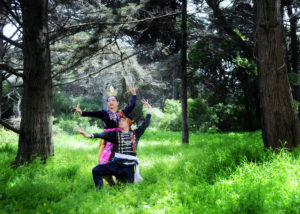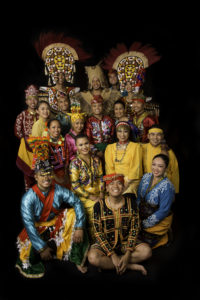
While experiencing Parangal Dance Company’s enchanting and powerful world premiere performance of Kiyaprawa a ko Arkat Lawanen (The Abduction of Princess Lawanen) during the San Francisco Ethnic Dance Festival at the War Memorial Opera House this past July, I was amazed by the scope and meticulous detail of this epic work, which was drawn from a legendary poem of the Meranao people of Mindanao (the Philippines large southern island).
I waited to interview Parangal’s Artistic Director Eric Solano and Musical Director Major Julian until after their run of shows so I could catch them at what I assumed would be a more relaxed time. After all, the amount of work that had gone into that performance was intense, and I knew they were preparing the performance on top of full-time day jobs, I was quite confident the week after the Festival was going to be a quiet one for Parangal’s leadership.
Making that assumption was how I found myself in front of my computer one morning at 6am, FaceTiming with Solano and Julian, who had in fact immediately followed their triumphant Festival performance by taking a large component of the company to perform at a city-wide festival in Barranquilla, Colombia. I should have known better – Parangal Dance Company are unstoppable and have a dynamic verve that can’t be contained to the Bay Area alone.
Solano comes to his work as director and choreographer of Parangal with great ambitions.
“There are 110 distinct ethnic communities spread all over the Philippines, and I want Parangal to present as many of them as possible,” he tells me. The company has performed dances from over 30 different indigenous cultures in their 10-year lifespan, which they will celebrating this October with a set of anniversary shows at the Scottish Rite Center in San Francisco.

Born in the Philippines and raised in the Bay Area, Solano approaches dance as a means to reconnect with his culture. He danced with Barangay Dance Company into the early 00’s, gradually taking more responsibility within the group. As he developed his own approach to working with dancers, he decided to form his own company. Parangal Dance Company began in 2008, and for the first few years followed the same method of dance presentation that Solano had learned within Barangay.
In 2011, he shared that “the landscape of our work began to change…we began to focus less on the Christian and Spanish-influenced dances,” that are an outcome of 300 years of Spanish colonization of the Philippines “and more on the indigenous dances.”
As Solano describes it, he realized he wanted to make a “180-degree turn away,” not only in what kinds of dance he practiced, and in the process of how he and company learned about the dance and culture by “working more closely with the indigenous people” who had created and developed the dance forms. For Solano this process means “that you don’t only learn about their culture and traditions, you learn what their needs as a community are, and what it takes to pass the culture on to the next generation.”
As an outgrowth of this new direction, Julian began pushing the musical development of the company further. Born and raised in the Bay Area, he was also drawn to Filipino dance and music as a way to reconnect with his heritage. He had a background playing western music, and after dancing with Eric for several years, asked if he could take over the musical side of things in Parangal. With Julian’s musical leadership, they moved away from performing to recorded music and live music became a staple component of their performances.
Speaking with Solano and Julian, I begin to understand how the process of creation for Parangal has transformed from being exclusively results-driven in the past; using whatever means possible to learn the dance (often learning the choreography from videos) with the primary goal being the end product of a show, towards a process-driven focus. By placing an increased emphasis on the journey of creation and discovery in collaboration with leaders in the indigenous communities where the dances come from, and valuing creative process just as much as final performance, Parangal’s dance work has great depth.
And the way they do it know is certainly not easy: At the beginning of each year, Solano and a group of company members take immersion trips to the Philippines where they reach out to communities in the different islands to build relationships around the transmission of dance and music from the tribe or community to the company.
Eric says, “I pull out the iPad and show them what we’ve done with other communities and sometimes they say no, and we have to respect that.” While that’s a frustrating response for someone so enthusiastic about sharing the diversity of indigenous Filipino culture, Eric feels that “sometimes that’s just how it goes,” and respects that community’s autonomy. The Parangal process only works with engaged communities who want to be in partnership with the company.
Julian explains that the trust-building process can be challenging. There are times when a tribe’s initial response will be “you’re going to learn from us, you’re going to exploit us, and we’ll never hear from you again and then you’re going to make a profit.” But in most cases, leaders in the community place their trust in Parangal to serve as caretakers of their dance and music and agree to the partnership.
It’s important to Solano that audiences understand that while Parangal is “not the indigenous group performing – we take the dance and set it for a western stage – but the group is included in the process.” Each performance includes the input of “culture-bearers,” leaders and elders from the community where the dance originated, who are closely involved in teaching the dance to Solano and the company, and “we also try to do what’s in our control to support the group.” This includes paying the tribes and communities to create the traditional outfits that Parangal dancers wear during performances.

The partnership is central to how Solano re-designs the dances for the stage, and more importantly to how the dancers relate to the movements he sets on them. “I’m really happy they can experience it, it’s more hands-on for them, and they can connect the dots between how I’m telling them to move and their experience working with the group back in the Philippines,” he says.
Julian explains the complication of trying to gather the right instruments for a dance. “As a foreigner to them, as an American, I show up and ask for what is essentially a family heirloom,” which can lead to some difficult conversations, but he says it always comes back to the fact that Parangal wants to share the indigenous group’s culture, and the culture-bearers want their culture to be shared, “and the music tells your story as much as the dance does, so if they have an extra instrument … [they might] sell [us] an instrument that’s generations old.”
“Sometime if an instrument is made out of wood, a new instrument can be made for the company to come back to the states with,” Julian tells me, continuing: “there’s this one particular instrument, it’s basically a tree trunk, so they cut down five trees, and carve them to get the right pitch.” He continues, “once they do that, they ship it and we hope that it can pass customs, but there have been times when [wooden instruments] get to SFO and it had termites, so customs has to burn it.”
Julian laughs as he shares the struggles that went into acquiring that instrument: “when we bought it the first time the whole termite thing happened, when we bought it the second time it was lost in transit, but I guess third time’s a charm.” The instrument arrived and will be part of Parangal’s audition for the 2019 San Francisco Ethnic Dance Festival later this fall.
This coming October audiences will have the opportunity to witness the full scope of what Solano, Julian, and the company have been working on for the past decade. The show will cover forms of dance from all three island regions of the Philippines: Luzon in the north, the Visayas in the middle, and the southern Mindanao. In addition, the company is working to bring some culture bearers from the Philippines for the first time to participate in the show. The title of the show is Padayon, which means “moving on” or “forward.”
Solano tells me that “there will be four world premieres, including two [dances from] ethnic groups that haven’t been featured before.” He gets excited speaking about the breadth of cultural forms on display. When they sit down with the indigenous groups during their immersion trips, he tells me that “we always begin with a set of questions, and…once you start going through each of them you will see a pattern of similarities among the indigenous groups – they will have different terms and different ways of describing things, but you will see a connection with something similar in another group.”
At the same time he concludes that, “it’s really exciting to learn about all those differences and how they came about, and we try to put all of that into our performances,” the most important aspect to the Parangal process is that “we want to present dance with integrity.”
This article appeared in the September 2018 edition of In Dance.

